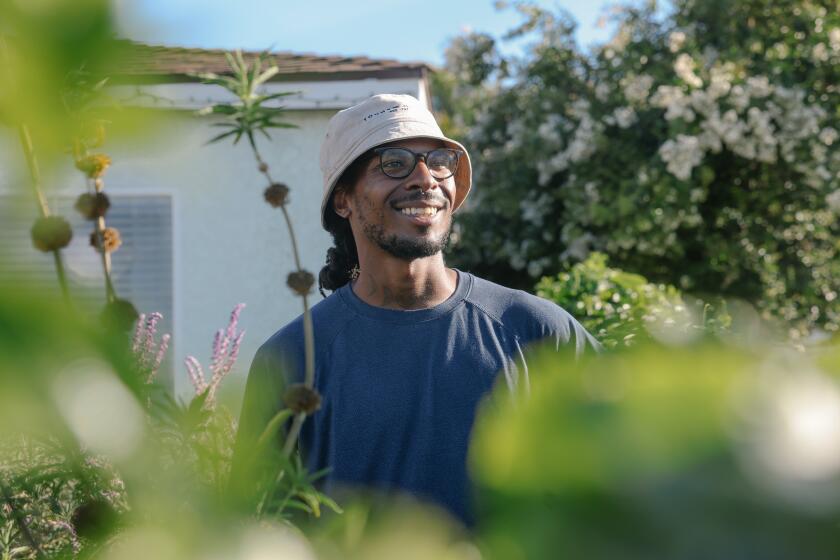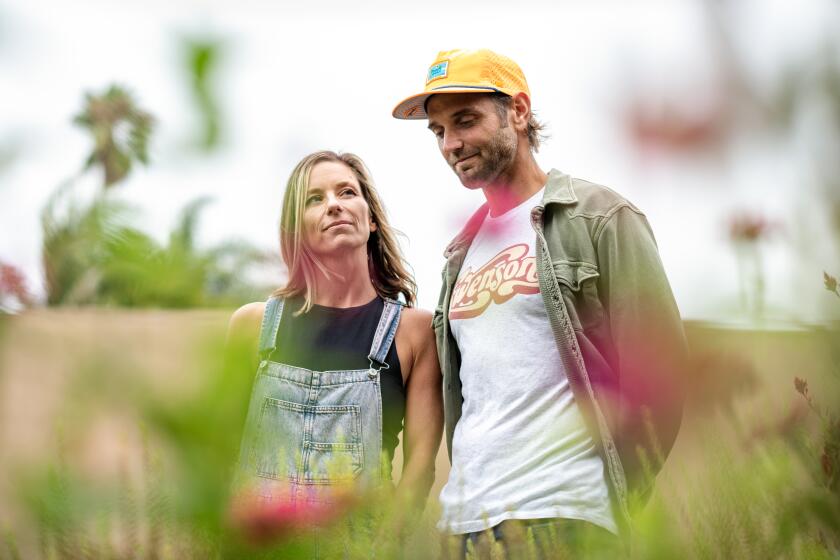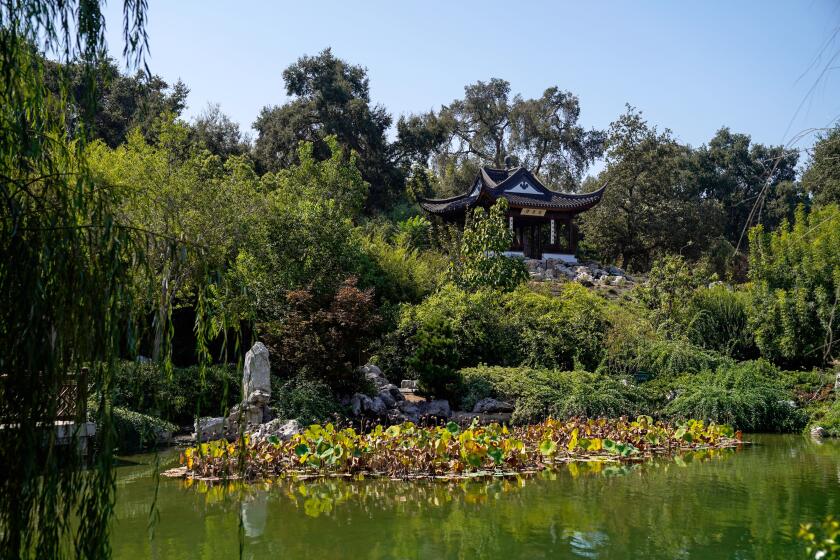
- Share via
It’s hard to say what’s cooler about the Japanese shōya house at the Huntington Library, Art Museum, and Botanical Gardens — the centuries-old wood structure that was once the center of a small farming village in Marugame, Japan, or the backstory of how it got to its new home at the Huntington’s Japanese Garden.
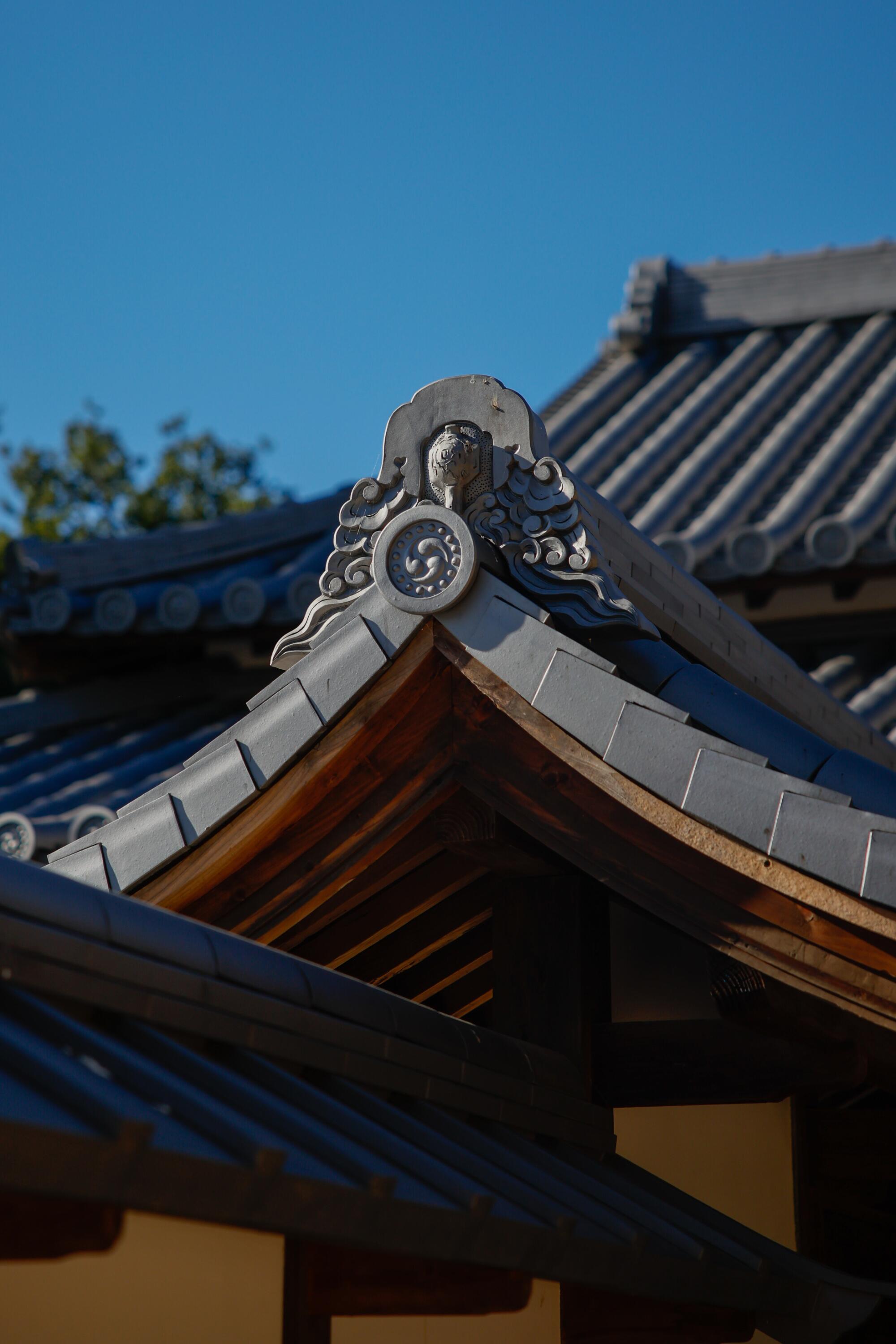
The journey took nearly eight years of negotiations, bureaucratic wrangling and skilled craftsmanship to dismantle, reassemble and, in some cases, re-create the 3,000-square-foot house and gardens. And starting Saturday, visitors can finally tour the compound, which will be open daily from noon to 4 p.m. (except Tuesdays, when the gardens are closed).
Los Angeles-based Akira and Yohko Yokoi donated their ancient family home to the Huntington, but the $10 million job of moving it to San Marino was far more complicated than just taking apart a puzzle and putting it back together.
Consider the distinctive conical ceramic tiles covering the pitched roof like rows of tight curls. All those silver-gray tiles had to be remade by Japanese craftsmen because the originals were mortared to the roof and had to be broken to disassemble the house. The exquisite garden outside the largest and most important room of the house was carefully mapped and measured, and every stone numbered by landscape designer Takuhiro Yamada so it could be re-created at the Huntington.
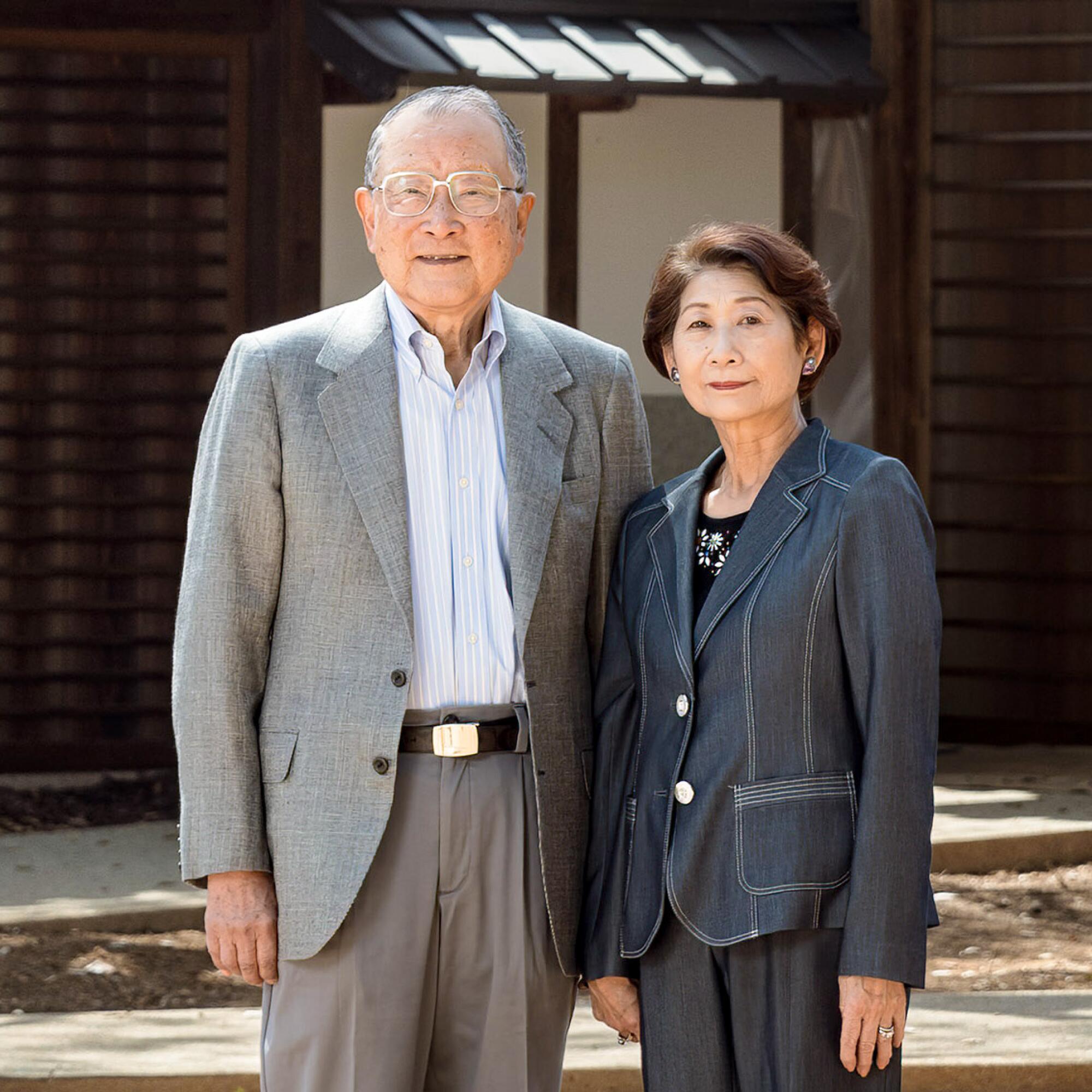
For work, he tends roses at the Huntington. At home, he inspires his Watts neighbors with his low-cost, DIY garden full of native plants, herbs and food.
And outside the gatehouse that protected the house, built new because the original was damaged by a storm, the Huntington installed a terraced mini farm growing small plots of rice, buckwheat, sesame, wheat and other traditional Japanese crops, surrounded by a riot of colorful cosmos flowers. The house sits higher than the farmland, so water collected from the roof and ponds all drains down to irrigate the farm land.
So this installation isn’t just an exercise in cultural awareness, says curator Robert Hori, the Huntington’s associate director of cultural programs, who oversaw the project from start to finish. To him, the Japanese Heritage Shōya House is a quiet but effective example of sustainability — “learning from the past for a better future” — and a reminder that farmers “are really the backbone of our society.”
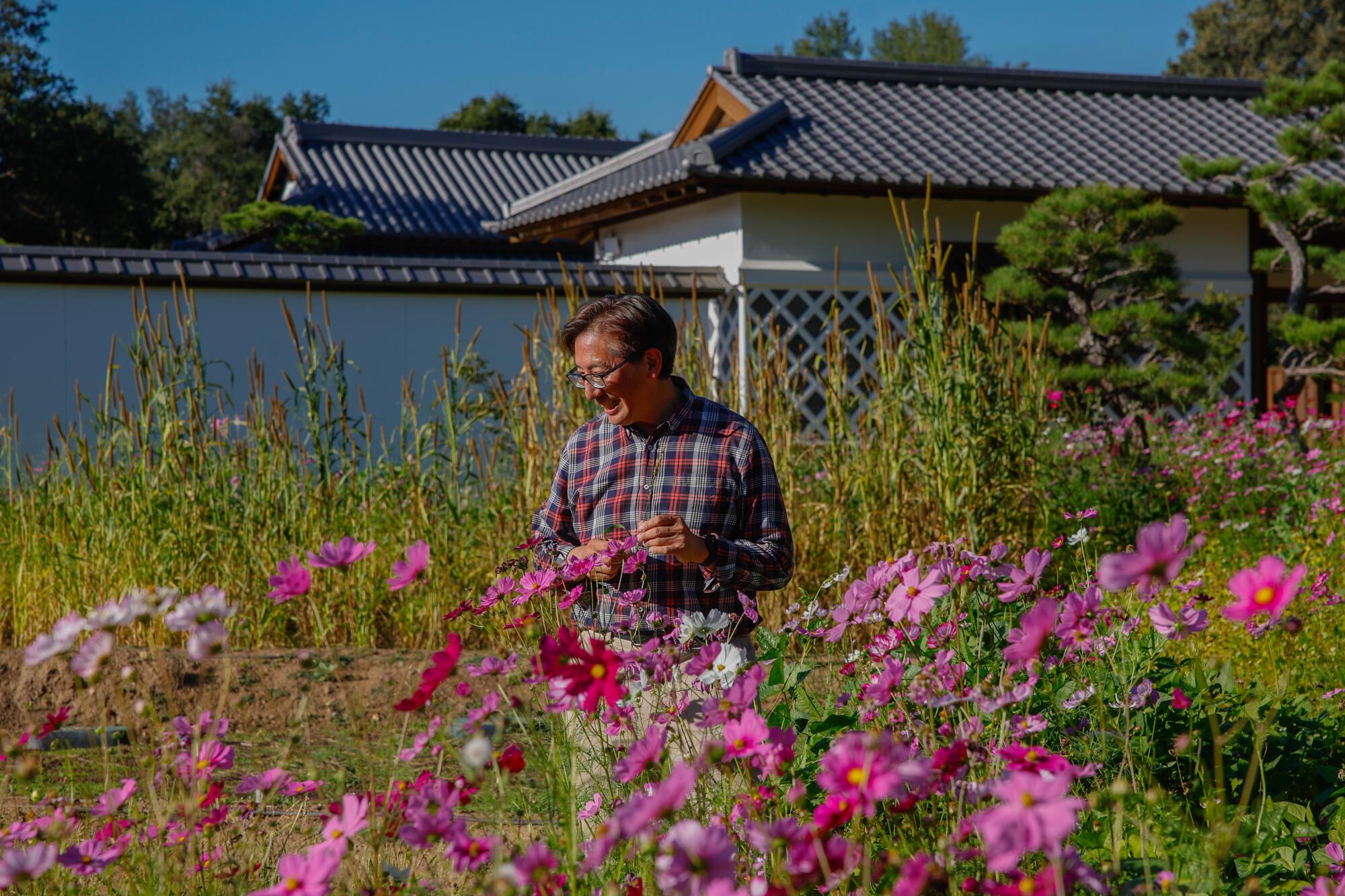

There were plenty of trying times — more than two years of negotiating with city, state and federal officials to get the necessary approvals and occupancy permit to move and rebuild the house. And in the midst of the pandemic, when the disassembled house sat in dozens of packing crates for nearly nine months, Hori had to coax reluctant Japanese craftspeople to come and put it together so the ancient wood pieces didn’t warp in SoCal’s dry summer heat.
“When you’ve spent two years lovingly repairing this wood and then you’re told everything might be lost, that was a call to action to the craftspeople who painstakingly worked on this,” says Hori. “Even in the face of a pretty scary time, they felt like it was their responsibility to put this house back together.”
Chad and Stacie Vanags’ backyard cutting garden has become a healing sanctuary for the couple and others, following Chad’s Stage 4 lung cancer diagnosis.
The project started with a chance meeting in 2016 during a party at the Beverly Hills home of Los Angeles philanthropist Jacqueline Avant. Hori had come to talk with Avant about a Japanese art collection she wanted to donate to the institution. During their conversation, Avant introduced Hori to her friend, Yohko Yokoi, who soon would be traveling to Japan.
“I said, ‘Oh, that will be a wonderful visit because the cherry blossoms will be in full bloom,’” Hori recalls, “and [Yokoi] said, ‘No, because I have to take care of my house.’ And then she began to tell me the story of this house.”
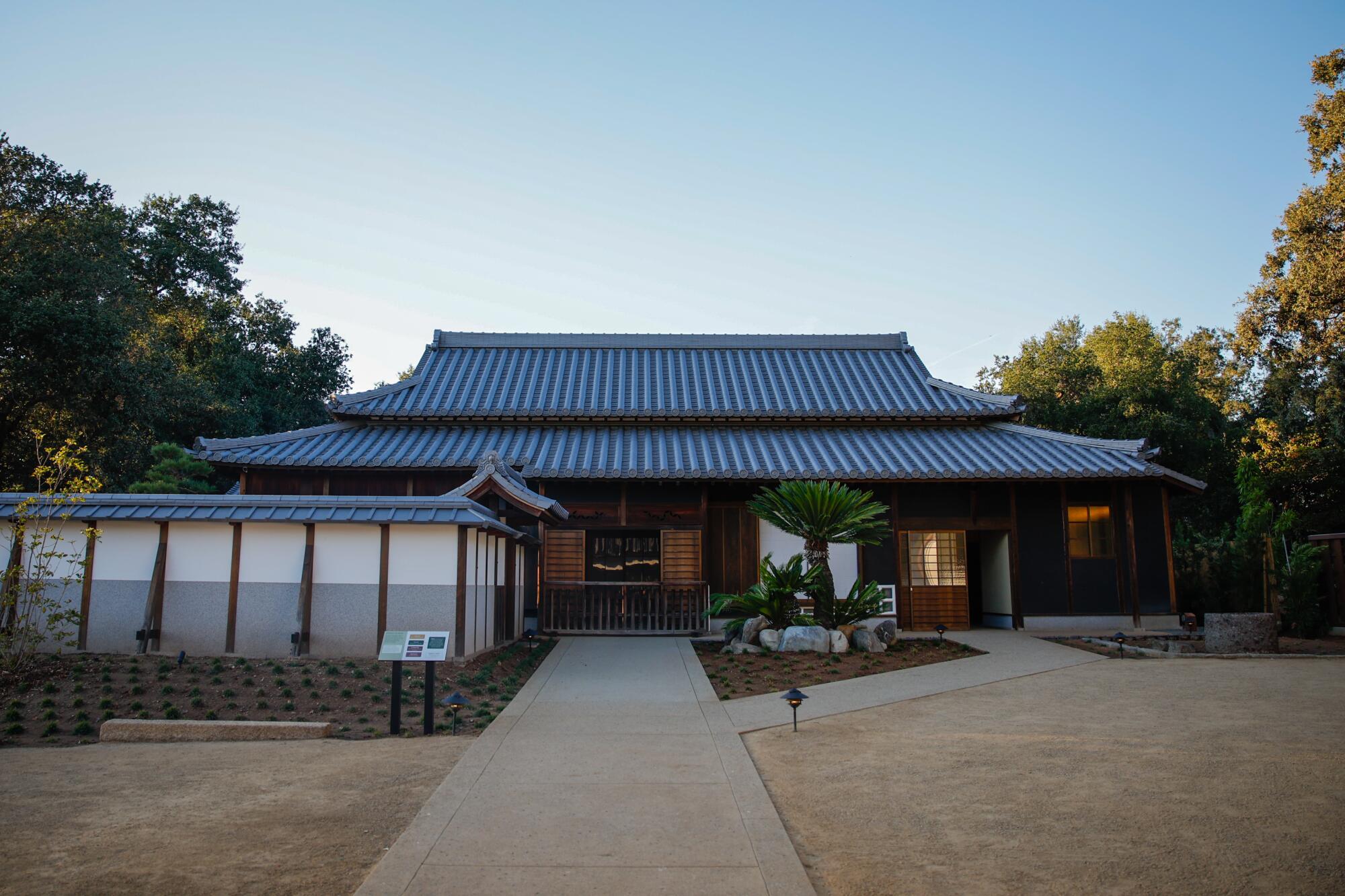
Hori recalls Yokoi saying the house had been built after the war, “so I thought it was a prefab house from the 1950s with poor construction, built after World War II. But then she was saying, ‘We used to have a castle,’ and that’s when it came to light that this house was built around 1700, after the war that unified Japan.”
Prior to that final battle, Japan had been a confederation of warring city-states and provinces, he said. It took 100 years of battles to create a cohesive central government known as the Tokugawa Shogunate. The Yokoi family’s castle was destroyed during the war. They had been fighting on the losing side, Hori said, but the victorious Tokugawa clan decided to incorporate all the losing factions into its new bureaucracy, to become tax collectors and shōya, or village leaders.
Sign up for our L.A. Times Plants newsletter
At the start of each month, get a roundup of upcoming plant-related activities and events in Southern California, along with links to tips and articles you may have missed.
You may occasionally receive promotional content from the Los Angeles Times.
The Yokoi shōya house was built around 1700 in Marugame, says Hori, and was the family’s private residence as well as a kind of community center for the village.
Inside the gatehouse, a large courtyard provided space for weddings, funerals and celebrations. Farmers and merchants entered the shōya house through one entrance, to measure and store their rice, pay their taxes and try to collect funds for other provisions. These rooms had floors made from hard-packed earth, and rustic beams hand-hewn from pine.
Adjacent to the dirt-floored rooms were the places where the family lived and worked. These raised floors were covered with rice-straw tatami mats. The wood-framed walls and beams were planed to feel as soft to the touch as satin sheets. Sliding walls with windows covered in rice paper and glass opened to reveal exquisite gardens, enjoyed only by visiting dignitaries who entered through their own special gate.
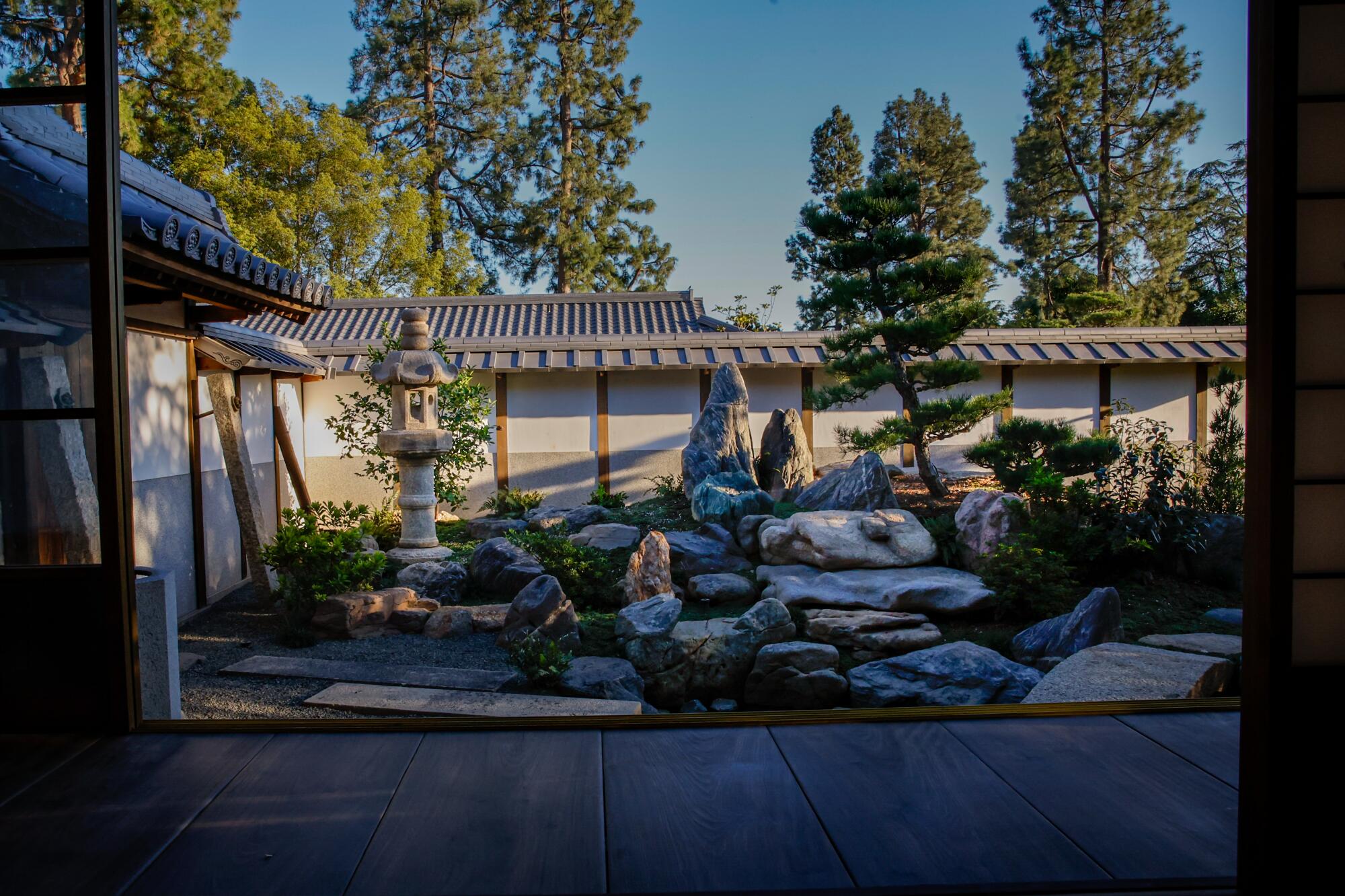
After the military shogunate system was overturned in the late 19th century, the house became the Yokois’ private residence and went through several renovations, according to Yokoi and her husband, Akira. The last family member to live there was Akira’s mother, who died around 1988. The couple moved to California in the late 1960s, says Hori, where Akira worked as an executive for Matsushita Panasonic, the parent company of Panasonic. They visited the house regularly and kept it maintained, with the idea of retiring there someday.That plan faded, however, and eventually, he adds, the upkeep became a chore.
Hori already was thinking about a big project for the Japanese Gardens when he first met Yohko Yokoi. The Huntington’s Chinese Garden was in the midst of a huge expansion, and the discussion was how to add to the Japanese Garden to balance the two, says Hori. “This was an ongoing conversation we’d been having [at the Huntington] since 2012, and I’d been taking several trips to Japan to figure out what we should be adding next to that garden,” he says.
The Yokoi house sounded promising, so even though he had just returned from a visit to Japan, he made another trip within a few weeks so he could see the house while Yokoi was visiting. And that’s when he got the vision that sustained him through all the difficult years to come.
The final phase of the Huntington’s famed Chinese Garden is scheduled to open Oct. 9, with an additional 11.5 acres, or 15 acres total with new pavilions, landscaping and — someday — even restaurants.
“I thought it had good bones when I first went to look at it, but also, I was interested in the house because it was really a conglomerate of various styles: the front room with its very rustic wood beams and style on one side, and then on the other side a formal reception room with the elegant carvings and mix of styles; a public face and private face of a scale big enough to accommodate visitors circulating through it.”
There were other signs too. The Huntington’s historic Japanese Garden, with its curved wooden Moon Bridge over a small lake and display of a Japanese home, first opened in 1912 when the West was fascinated by Japanese culture, plants and architecture. The garden fell into disrepair during World War II but was refurbished with support from the San Marino League. In 1968, the garden was expanded with a bonsai collection and Zen Court of plants and raked stones. Then in 2010, the Pasadena Buddhist Temple donated a small ceremonial tea house to the garden, which was disassembled and sent back to Japan to be refurbished before being shipped back to San Marino, where it was reassembled.
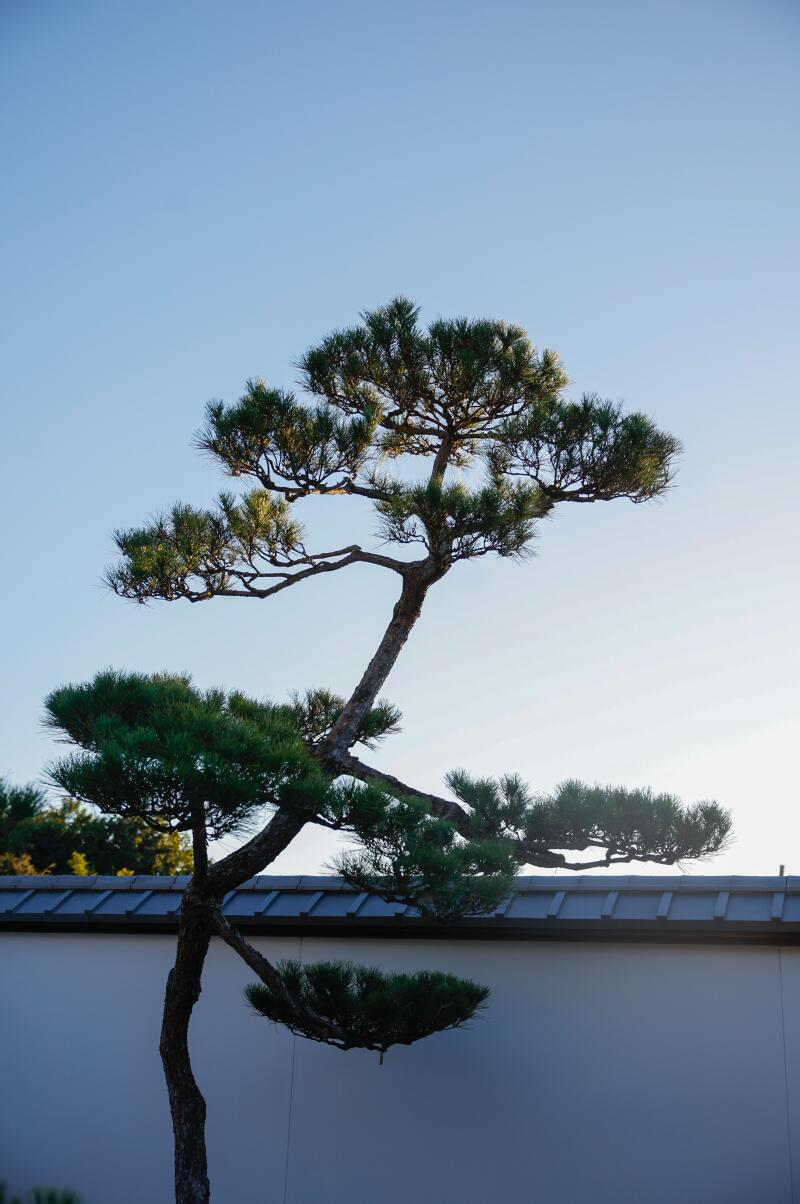
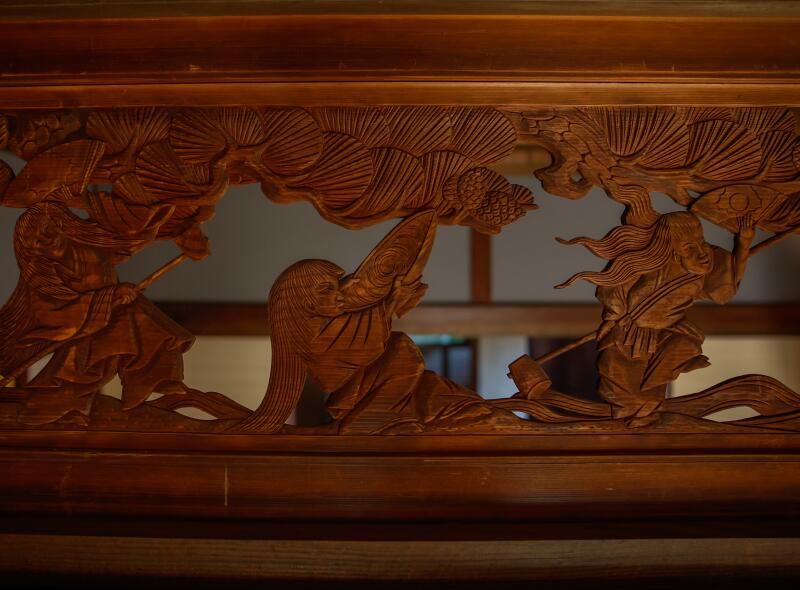

Japanese black pine (Pinus thunbergii) rises above the shōya house gatehouse. An intricate carving of farm life at the top of the entrance to the shōya house’s grand room. A soft wood walk way surrounds the perimeter of the shōya house. (Jason Armond / Los Angeles Times)
The tea house was much smaller than the shōya house, says Nicole Cavender, director of the Huntington’s botanical gardens, but it gave them the confidence to tackle a much larger structure and create a reconstruction of village life.
“We wanted this to be an immersive experience,” says Cavender, “so it has to be productive as well as beautiful.” The fields of tall magenta, pink and white cosmos flowers that edge the farm weren’t added just to enchant, she said, “but to show that we’re actually trying to grow something. The flowers draw pollinators who help the crops grow.”
After a three-year closure and 18-month renovation, the Huntington Library, Art Museum and Botanical Gardens reopens its tea room with an outdoor addition.
Eventually there will be koi in the garden pond by the house, and the water circulating in that pond will be enriched with their poop, she says, and help feed the farmland below. Around the house is decorative edging called rain catchers — narrow drains filled with smooth gray rocks to collect any rain or dew falling off the roof, which also drained to the farming areas below.
Three hundred years ago, the Japanese didn’t have a word for sustainability, but they lived the concept every day with this type of regenerative farming, says Hori. “It’s how you survived. We want people to understand that ornamental gardening started with the ability to move water, and to move earth, which is what we have in farming. It all came out of farming.”
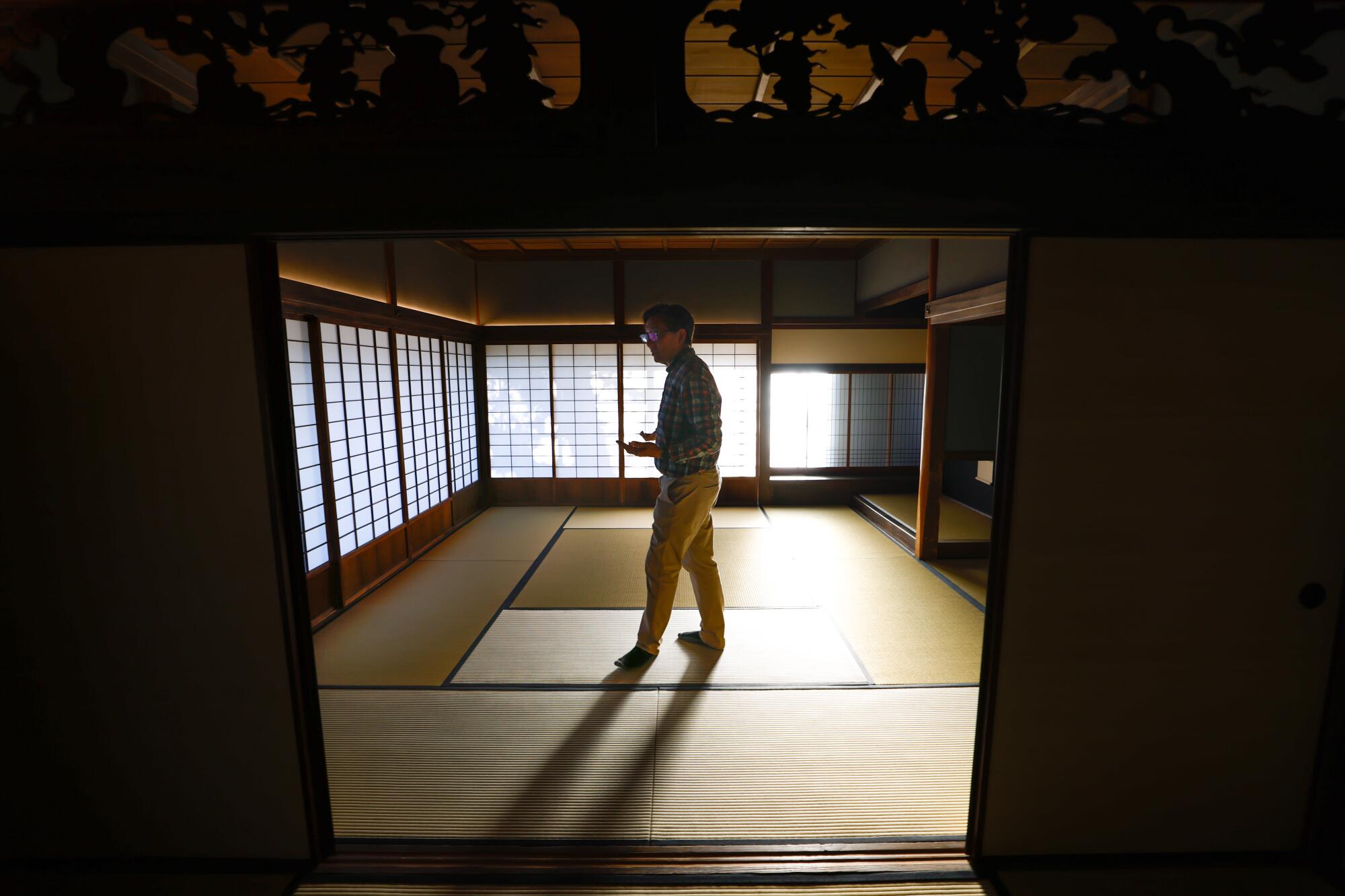
Hori’s vision encompasses more nuanced lessons too. The house has few furnishings. The smooth wood decking around the perimeter of the house is patched in places where the wood was worn, but the patches were done decoratively in the shape of a small gourd. And the simplicity of the furnishings is a gentle question.
“It gets you thinking ... do we really need all this stuff we have? We want this to be a living museum, and walking through the house you can really find the three Rs of sustainability — reduce, repair and recycle, reuse or remake,” says Hori.
“It was all part of a circular economy where nothing was wasted. A ‘circular economy’ is a big concept, but we’re hoping these small doses of a big concept can help people take away these lessons and understand them. As a nonprofit we are in the business of inspiring and changing lives. We can make a difference, and that’s a great thing to come to work to.”
More to Read
Sign up for The Wild
We’ll help you find the best places to hike, bike and run, as well as the perfect silent spots for meditation and yoga.
You may occasionally receive promotional content from the Los Angeles Times.
